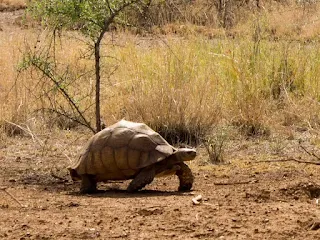Sulcata tortoises, also known as African spurred tortoises, are the third-largest tortoise species in the world and one of the most popular among reptile enthusiasts. Native to the arid regions of sub-Saharan Africa, Sulcatas require a specific environment that mimics their natural habitat to thrive in captivity. A well designed Sulcata tortoise habitat is crucial for their physical health, mental stimulation, and overall longevity.
This guide covers everything you need to know about building and maintaining the perfect Sulcata tortoise habitat, whether you’re raising a hatchling indoors or caring for a full-grown adult outdoors. From enclosure types to temperature control, lighting, substrate, and enrichment, this comprehensive guide will help ensure your tortoise lives a long, healthy, and happy life.
1. Understanding Sulcata Tortoise Habitat Needs
Before designing the habitat, it’s important to understand the environmental conditions Sulcatas are adapted to:
-
Climate: Hot, dry, and sunny with occasional periods of rain.
-
Terrain: Sandy, rocky soil with sparse vegetation.
-
Burrowing Behavior: Sulcatas are natural diggers and use burrows to regulate temperature and humidity.
Recreating these conditions in captivity is key to avoiding health issues such as respiratory infections, shell deformities, and stress.
2. Indoor vs. Outdoor Enclosures
Indoor Enclosures
-
Best for hatchlings and juvenile tortoises.
-
Allows easier control over temperature, humidity, and lighting.
Outdoor Enclosures
-
Ideal for adult tortoises in suitable climates.
-
Offers natural sunlight, more space, and stimulation.
Factors to Consider:
-
Local climate and weather extremes
-
Security from predators
-
Available space
3. Minimum Size Requirements
Sulcatas grow rapidly and can reach over 100 pounds, so space is critical:
-
Hatchlings (0–1 year): 3' x 2' indoor enclosure
-
Juveniles (1–5 years): 6' x 4' or larger
-
Adults (5+ years): Outdoor enclosure of at least 100 square feet
Pro Tip: Bigger is always better. A cramped enclosure leads to stress and limited natural behavior.
4. Substrate Selection
Substrate mimics the ground surface and helps regulate humidity and temperature.
Best Substrate Materials:
-
Coconut coir
-
Organic topsoil (no fertilizer or pesticides)
-
Cypress mulch
-
Hay (for dry areas of the enclosure)
Avoid:
-
Sand (impaction risk)
-
Gravel or pebbles (abrasive and swallowable)
-
Pine and cedar (toxic oils)
5. Temperature and Heating Requirements
Sulcatas require a temperature gradient to self-regulate their body temperature:
-
Daytime Temperature: 85–95°F (29–35°C)
-
Basking Spot: 100–110°F (37–43°C)
-
Nighttime Temperature: 70–80°F (21–27°C)
Heating Equipment:
-
Ceramic heat emitters
-
Mercury vapor bulbs
-
Under-tank heaters
-
Heat mats (with thermostat controls)
Monitoring Tools:
-
Digital thermometers with probes
-
Infrared temperature guns
6. Humidity and Hydration
Despite being desert dwellers, Sulcatas need proper humidity to avoid dehydration and shell pyramiding.
-
Humidity Levels: 40–60% for adults, up to 70–80% for hatchlings
Hydration Tips:
-
Provide shallow water dishes
-
Weekly soaks for adults; 3–4 times weekly for hatchlings
-
Use humidity hides (moist shelters with sphagnum moss)
7. Lighting and UVB
UVB lighting is essential for calcium absorption and preventing metabolic bone disease.
-
Lighting Duration: 10–12 hours/day
-
UVB Bulbs: Use T5 HO linear UVB bulbs (10.0 strength recommended)
-
Sunlight: Nothing beats natural sunlight. Outdoor tortoises should still have access to shaded areas.
Replacement Tip: Replace UVB bulbs every 6–12 months, even if they still emit visible light.
💡 Need the best lighting solution? Check out the Tortoise Best Habitat Lighting
8. Shelter and Hiding Spots
Sulcatas need shelters to regulate body temperature and feel secure:
-
Indoor Hides: Wooden or plastic reptile caves
-
Outdoor Shelters: Insulated dog houses, burrows with reinforced entrances
-
Burrowing Zones: Allow digging or provide artificial burrows in safe locations
🏡 Enhance their environment with natural elements—explore the Tortoise Best Habitat Decoration
9. Outdoor Habitat Construction
Designing an outdoor enclosure requires more planning:
-
Fencing: Minimum 18–24 inches tall, sunk at least 12 inches into the ground
-
Materials: Cinder blocks, wood, welded wire mesh
-
Shelter: Waterproof, windproof, insulated shelters
-
Vegetation: Drought-tolerant grasses, edible weeds, aloe vera
10. Enrichment and Natural Behaviors
Stimulating your Sulcata mentally and physically improves overall health:
-
Climbing Areas: Smooth rocks and mounds
-
Safe Plants: Hibiscus, dandelion, plantain
-
Tunnels and Mazes: Encourage exploration
-
Interaction: Gentle handling and supervised outdoor time
11. Cleanliness and Maintenance
Routine cleaning prevents bacterial build-up and promotes health:
-
Spot clean daily
-
Full substrate change every 4–6 weeks
-
Disinfect water bowls and hides weekly
-
Ensure ventilation
12. Seasonal Adjustments
-
Winter: Bring tortoise indoors if below 60°F (15°C); use heated shelters outdoors
-
Summer: Provide shaded areas and hydration; mist during extreme heat
13. Indoor Enclosure Ideas
-
Tortoise Tables: Elevated wooden enclosures
-
Large Plastic Tubs: Affordable and easy to clean
-
Custom Terrariums: Plexiglass or wood with screen lids
Tip: Ensure ventilation while maintaining warmth and humidity.
14. Safety Considerations
-
Avoid small objects
-
Keep away from pets
-
Use non-toxic materials
-
Predator-proof outdoor pens
15. Long-Term Planning
Sulcatas live 50–100 years:
-
Plan for eventual size and weight
-
Ensure your property accommodates large pens
-
Have a care/emergency plan
Designing the perfect Sulcata tortoise habitat is a rewarding journey that ensures your tortoise lives a healthy and fulfilling life. From choosing the right substrate and lighting to building safe and enriching environments, every detail matters. Whether indoors or outdoors, hatchling or adult, your Sulcata’s habitat should reflect their natural environment while prioritizing comfort, safety, and health.
